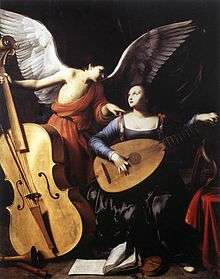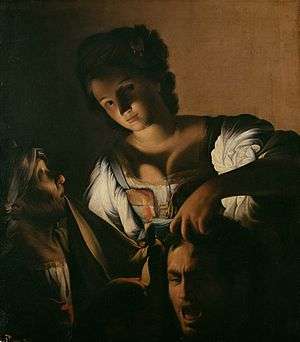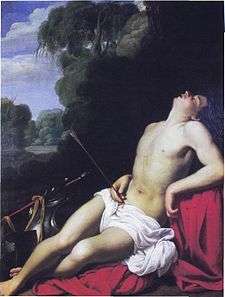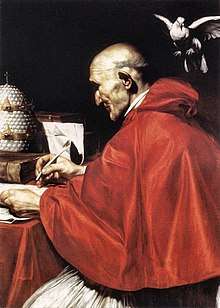Carlo Saraceni
Carlo Saraceni (1579 – 16 June 1620) was an Italian early-Baroque painter, whose reputation as a "first-class painter of the second rank" was improved with the publication of a modern monograph in 1968.[1]
Carlo Saraceni | |
|---|---|
 Anonymous, Portrait of Carlo Saraceni (1616) | |
| Born | 1579 Venice |
| Died | June 16, 1620 Venice |
Life
Though he was born and died in Venice, his paintings are distinctly Roman in style; he moved to Rome in 1598, joining the Accademia di San Luca in 1607. He never visited France, though he spoke fluent French and had French followers and a French wardrobe. His painting, however, was influenced at first by the densely forested, luxuriantly enveloping landscape settings for human figures of Adam Elsheimer, a German painter resident in Rome; "there are few landscapes by Saraceni which have not been attributed to Elsheimer," Malcolm Waddingham observed,[2] and Anna Ottani Cavina has suggested the influences may have travelled both ways.[3] and Elsheimer's small cabinet paintings on copper offered a format that Saraceni employed in six landscape panels illustrating The Flight of Icarus;[4] in Moses and the Daughters of Jethro[5] and Mars and Venus.[6]
When Caravaggio's notorious Death of the Virgin[7] was rejected in 1606 as an altarpiece suitable for a chapel of Santa Maria della Scala, it was Saraceni who provided the acceptable substitute, which remains in situ, the only securely dated painting of his first decade in Rome. He was influenced by Caravaggio's dramatic lighting, monumental figures, naturalistic detail, and momentary action, so that he is numbered among the first of the "tenebrists" or "Caravaggisti". Examples of this style can be seen in the candlelit Judith with the Head of Holofernes.
Saraceni's style matured rapidly between 1606 and 1610, and the next decade gave way to his fully mature works, synthesizing Caravaggio and the Venetians. In 1616–17 he collaborated on the frescoes for the Sala Regia of the Palazzo del Quirinale.[8] In 1618 he received payment for two paintings in the church of Santa Maria dell'Anima. The compositional details of his fresco of The Birth of the Virgin in the Chapel of the Annunciation of the church of Santa Maria in Aquiro are repeated in a panel on copper at the Louvre.[9]
In 1620 he returned to Venice, where he died in the same year.
Works

- Mars and Venus (1605–1610), oil on copper (São Paulo Museum of Art, São Paulo)
- Rest on the Flight into Egypt, 1606 (Eremo dei Camaldoli, Frascati)
- The Fall of Icarus (Museums and Art Galleries Naples, Museo e Gallerie Nazionale di Capodimonte, Naples)
- Madonna and Child with Saint Anne, painted for the Church of San Simeone Profeta, 1610 (Galleria Nazionale d'Arte Antica, Rome)
- Papal Authority, chalk preparatory sketch for an allegorical fresco (J. Paul Getty Museum)[10]
- Vision of Saint Francis (1615), Alte Pinakothek, Munich[11]
- Saint Cecilia and the Angel, c. 1610 (Galleria Nazionale d'Arte Antica, Rome), attributed to Saraceni[12]
- The Martyrdom of Saint Cecilia (LACMA)
- The Madonna and Child with Saint Anne and an Angel oil on copper (c. 1608–1610), Honolulu Museum of Art.[13]
- Nativity (Residenzgalerie, Salzburg)
- Carlo Borromeo Tending to Those Afflicted with Plague (Church of the Servi in Cesena)
Work by Saraceni can also be seen in the Roman church of San Lorenzo in Lucina.
Gallery
 The Madonna and Child with Saint Anne and an Angel, oil on copper, c. 1608–1610, Honolulu Museum of Art
The Madonna and Child with Saint Anne and an Angel, oil on copper, c. 1608–1610, Honolulu Museum of Art Rest on the Flight From Egypt
Rest on the Flight From Egypt Andromeda enchained, oil on panel
Andromeda enchained, oil on panel The Vision of St Francis
The Vision of St Francis.jpg) Mars and Venus, with a Circle of Cupids and a Landscape, oil on copper, 1605–1610, São Paulo Museum of Art
Mars and Venus, with a Circle of Cupids and a Landscape, oil on copper, 1605–1610, São Paulo Museum of Art Judith and the head of Holofernes, Kunsthistorisches Museum, Vienna
Judith and the head of Holofernes, Kunsthistorisches Museum, Vienna Saint Sebastian, Castle Museum, Prague
Saint Sebastian, Castle Museum, Prague Gregory the Great, attributed to the studio of Saraceni, c. 1610, Galleria Nazionale d'Arte Antica, Rome
Gregory the Great, attributed to the studio of Saraceni, c. 1610, Galleria Nazionale d'Arte Antica, Rome
References
- "un ottimo comprimario" in Francesco Arcangeli's words, quoted by R. Ward Bissell in reviewing Anna Ottani Cavina, Carlo Saraceni (Milan) 1968, in The Art Bulletin 53.2 (June 1971:248-250) p 248.
- Malcolm Waddingham, "A Landscape Masterpiece by Saraceni" The Burlington Magazine 114 No. 828 (March 1972:157, 159)
- Anna Ottani Cavina carefully distinguished Saraceni's landscape manner from Elsheimer's in Carlo Saraceni (Milan) 1968.
- Icarus is found in Museo di Capodimonte.
- Moses and the Daughters of Jethro is found in the National Gallery, London Archived 2006-05-22 at the Wayback Machine.
- Mars and Venus is found in Museo de Arte Saõ Paulo)"Archived copy". Archived from the original on 2006-06-10. Retrieved 2006-02-23.CS1 maint: archived copy as title (link).
- Caravaggio's Death of Virgin now at the Louvre)
- Giuliano Briganti, Il Palazzo del Quirinale (Rome 1962:37; among his collaborators there was the Venetian Marcantonio Bassetti, whose preparatory drawings are frequently confused with Sartaceni's (Stephen Polcari, "A Newly-Found Drawing by Saraceni" The Burlington Magazine 121 No. 914 (May 1979:307, 312).
- www.culture.gouv.fr
- "Papal Authority". The J. Paul Getty Trust. Retrieved 15 October 2019.
- "Die Vision des hl. Franziskus" (in German and English). Alte Pinakothek. Retrieved 15 October 2019.
- "Saint Cecilia and the Angel". Web Gallery of Art. Retrieved 15 October 2019.
- "New Acquisition" (PDF). Calendar News. Honolulu Academy of Arts. 76 (6): 7. November–December 2004. Retrieved 15 October 2019.CS1 maint: date format (link)
- Charles Dempsey, Keith Christiansen, Richard E. Spear, and Erich Scheier. 1985. The Age of Caravaggio. (New York: The Metropolitan Museum of Art)
External links
| Wikimedia Commons has media related to Carlo Saraceni. |
- Web Gallery of Art: Carlo Saraceni
- Jusepe de Ribera, 1591-1652, a full text exhibition catalog from The Metropolitan Museum of Art, which includes material on Carlo Saraceni (see index)